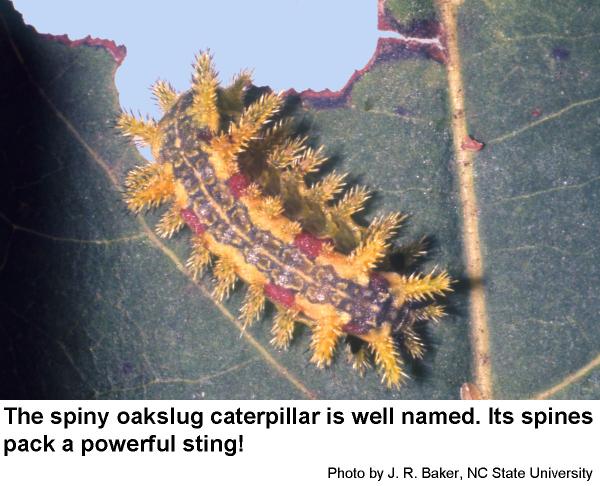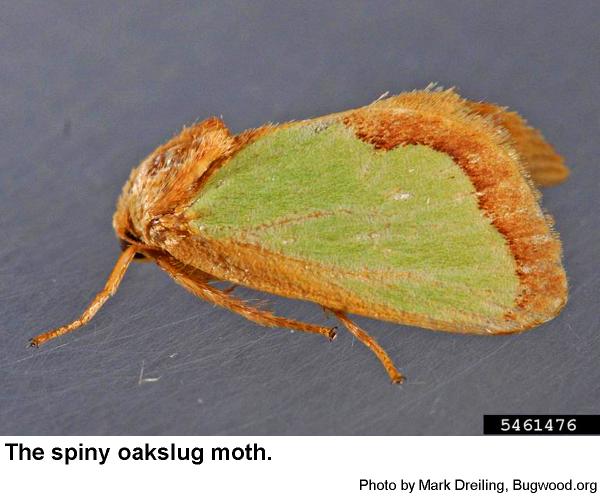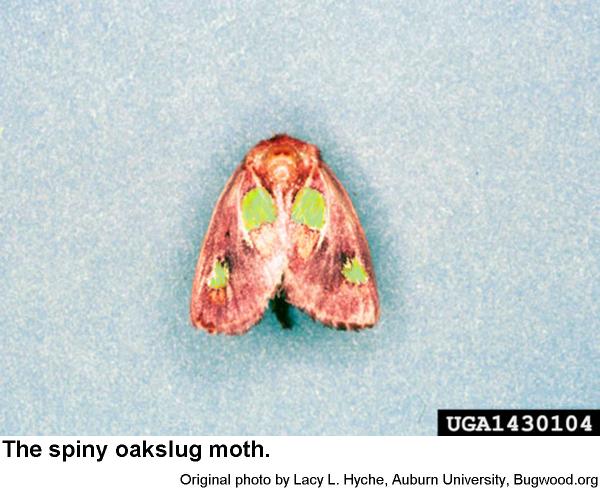Description and Biology
Spiny oakslug caterpillars, Euclea delphinii, are called "slug" caterpillars because the legs on the abdomen lack tiny hooks most other caterpillars have, and the prolegs are very short so that the caterpillars do sort of resemble slugs. The body is greenish with a dark, mottled stripe down the back with two rows of of spiny, yellowish lobes on either side. Another, shorter row of spiny lobes occurs around the lower perimeter. Two to four pairs of red spots decorate the top rows of spiny lobes. The moths are brown with a large green spot and sometimes a smaller green spot on each forewing. Several species of slug caterpillars including spiny oakslugs have stinging hairs (saddleback caterpillar, hag moth caterpillar, and stinging rose caterpillar) that can inflict a quite painful sting. Because spiny oakslugs usually rest on the lower surfaces of leaves, they are often overlooked. Some poor souls are very sensitive to these stings and may require immediate professional medical treatment. Spiny oakslugs overwinter as pupae in tough silk cocoons under their host plants. Those prepupae that spin larger cocoons are more likely to survive the winter. Spiny oakslug moths emerge the following May and fly throughout the summer. They scatter flat, oval eggs on leaves of various trees although occasionally eggs are laid in small clusters. About a week later, tiny spiny oakslugs hatch. The caterpillars are usually found feeding on lower, shaded branches, and they molt eight or nine times as they grow. Spiny oakslugs have been collected as late as September. Mature caterpillars spin a tough silk cocoon in which they molt into a pupa, their overwintering stage. We probably have one generation per year in North Carolina.
Host Plants
Although they are found on oak, spiny oakslugs also feed on bayberry, beech, cherry, chestnut, pear, sour wood, willow and various other trees and shrubs.
Residential Recommendations
Parasitic wasps and tachinid flies are active parasites of spiny oakslugs. This may explain why although the moths lay lots of eggs, spiny oakslugs are usually not abundant. Because this species is found in woodlands that are never sprayed with insecticides, it is susceptible to most insecticides labeled for home landscape use (especially pyrethroids) for sale in the garden sections of big box stores and garden centers. When used as directed, pyrethroids are very toxic to insects but are not particularly hazardous to humans and pets (other than fish-avoid using pyrethroids around pools, ponds, and streams). For a list of pesticides labeled for caterpillar suppression see the North Carolina Agricultural Chemicals Manual.
Other Resources
- Stinging Caterpillars, ENTFACT-003. Bessin. R. 2017 (revised). Entomology at the University of Kentucky.
- Life Histories of New York Slug Caterpillars. Dyar, H. G. 1897. Journal New York Entomological Society 5 (2): 57-66.
- Caterpillars that Feed on Trees and Shrubs. Frank, S. D. and S. B. Bambara. 2009 (revised). Entomology Insect Notes, NC State Extension Publications.
- Winter predation of diapausing cocoons of slug caterpillars (Lepidoptera: Limacodidae). Murphy S.M. and J. T. Lill. 2010. Environmental Entomology 39(6): 1893-902.
- Direct and indirect effects of light environment generate ecological trade-offs in herbivore performance and parasitism. Stoepler, T. M. and J. R. Lill. 2013. Ecology 94(10): 2299-310.
- Extension Plant Pathology Publications and Factsheets
- Horticultural Science Publications
- North Carolina Agricultural Chemicals Manual
For assistance with a specific problem, contact your local Cooperative Extension Center.
This Factsheet has not been peer reviewed.
Publication date: Nov. 25, 2017
Reviewed/Revised: Aug. 31, 2022
Recommendations for the use of agricultural chemicals are included in this publication as a convenience to the reader. The use of brand names and any mention or listing of commercial products or services in this publication does not imply endorsement by NC State University or N.C. A&T State University nor discrimination against similar products or services not mentioned. Individuals who use agricultural chemicals are responsible for ensuring that the intended use complies with current regulations and conforms to the product label. Be sure to obtain current information about usage regulations and examine a current product label before applying any chemical. For assistance, contact your local N.C. Cooperative Extension county center.
N.C. Cooperative Extension prohibits discrimination and harassment regardless of age, color, disability, family and marital status, gender identity, national origin, political beliefs, race, religion, sex (including pregnancy), sexual orientation and veteran status.



